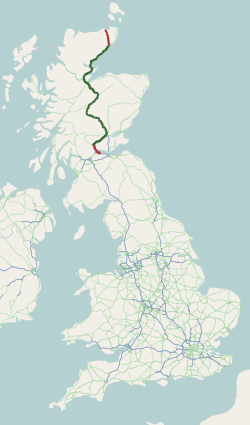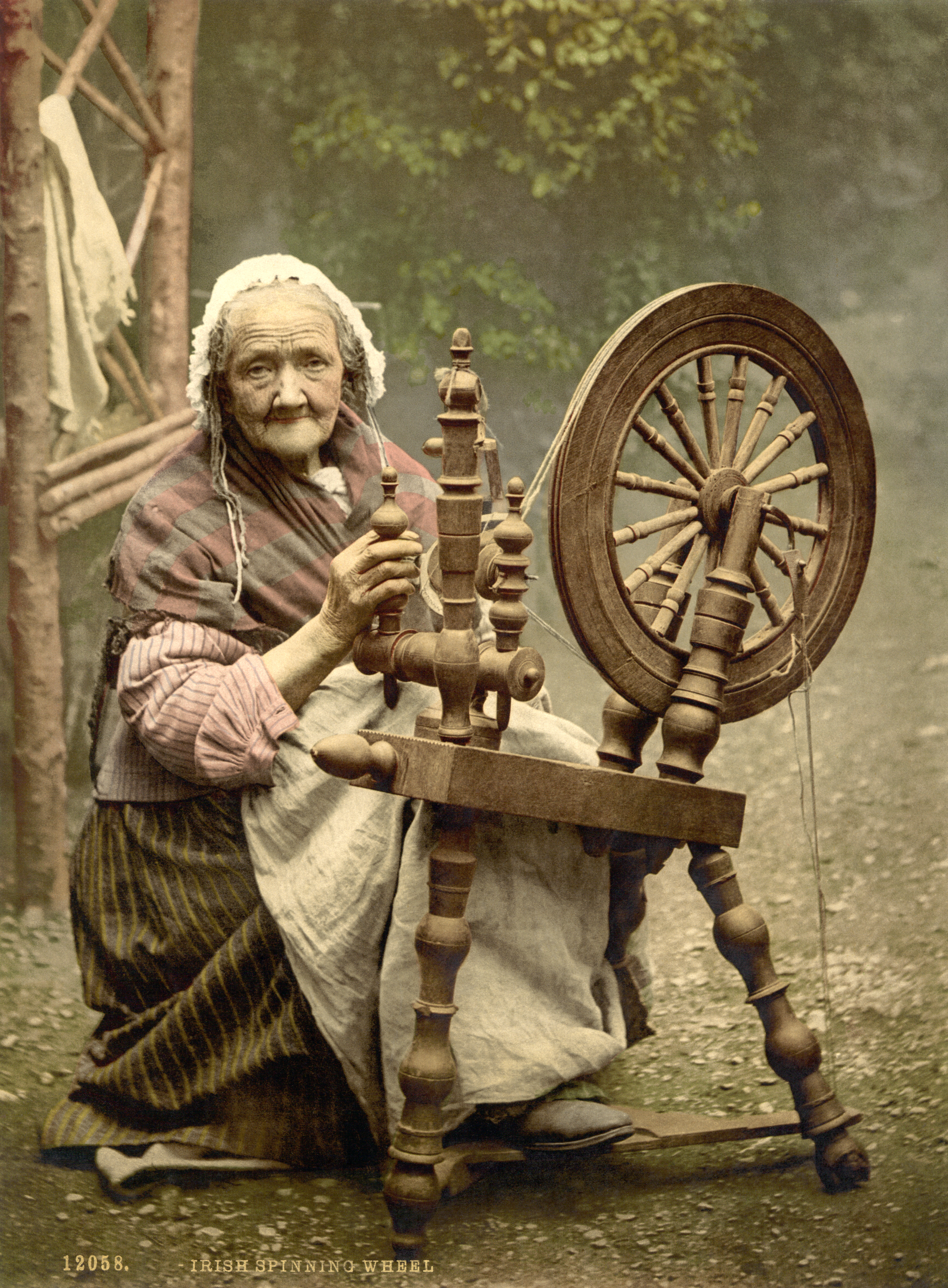|
Badbea
Badbea (pronounced bad-bay) is a former clearance village perched on the steep slopes above the cliff tops of Berriedale on the east coast of Caithness, Scotland. Situated around north of Helmsdale, the village was settled in the 18th and 19th centuries by families evicted from their homes when the straths of Langwell, Ousdale and Berriedale were cleared for the establishment of sheep farms. The last resident left the village in 1911 and a monument was erected by the son of former inhabitant, Alexander Robert Sutherland, who had emigrated to New Zealand in 1839. Today, the ruins of the village are preserved as a tourist attraction and memorial to the Highland Clearances. Geography Badbea is accessed by a footpath from a lay-by on the A9 road near Ousdale. The dwellings have all fallen into ruin, and little remains, other than a few drystone walls, although the outlines of the buildings and the remains of the crop fields are still visible. There is signage by the lay-by and ar ... [...More Info...] [...Related Items...] OR: [Wikipedia] [Google] [Baidu] |
Highland Clearances
The Highland Clearances ( gd, Fuadaichean nan Gàidheal , the "eviction of the Gaels") were the evictions of a significant number of tenants in the Scottish Highlands and Islands, mostly in two phases from 1750 to 1860. The first phase resulted from agricultural improvement, driven by the need for landlords to increase their income – many had substantial debts, with actual or potential bankruptcy being a large part of the story of the clearances. This involved the enclosure of the open fields managed on the run rig system and shared grazing. These were usually replaced with large-scale pastoral farms on which much higher rents were paid. The displaced tenants were expected to be employed in industries such as fishing, quarrying or the kelp industry. Their reduction in status from farmer to crofter was one of the causes of resentment. The second phase involved overcrowded crofting communities from the first phase that had lost the means to support themselves, through fa ... [...More Info...] [...Related Items...] OR: [Wikipedia] [Google] [Baidu] |
A9 Road (Great Britain)
The A9 is a major road in Scotland running from the Falkirk council area in central Scotland to Scrabster Harbour, Thurso in the far north, via Stirling, Bridge of Allan, Perth and Inverness. At 273 miles (439 km), it is the longest road in Scotland and the fifth-longest A-road in the United Kingdom. Historically it was the main road between Edinburgh and John o' Groats, and has been called ''the spine of Scotland''. It is one of the three major north–south trunk routes linking the Central Belt to the Highlands - the others being the A82 and the A90. The road's origins lie in the military roads building programme of the 18th century, further supplemented by the building of several bridges in later years. The A9 route was formally designated in 1923, and originally ran from Edinburgh to Inverness. The route was soon extended north from Inverness up to John O'Groats. By the 1970s the route was hampered by severe traffic congestion, and an extensive upgrading pro ... [...More Info...] [...Related Items...] OR: [Wikipedia] [Google] [Baidu] |
Sir John Sinclair, 1st Baronet
Sir John Sinclair of Ulbster, 1st Baronet, (10 May 1754 – 21 December 1835), was a British politician, a writer on both finance and agriculture, and was one of the first people to use the word ''statistics'' in the English language, in his vast, pioneering work, ''Statistical Account of Scotland'', in 21 volumes. Life Sinclair was the eldest son of George Sinclair of Ulbster (d. 1770), a member of the family of the earls of Caithness, and his wife Lady Janet Sutherland. He was born at Thurso Castle, Caithness. He was educated at the High School in Edinburgh. After studying law at the universities of Edinburgh and Glasgow and Trinity College, Oxford, he completed his legal studies at Lincoln's Inn in London in 1774. He was admitted to the Faculty of Advocates in Scotland in 1775, and also called to the English bar, although he never practised. He had inherited his father's estates in 1770 and had no financial need to work. In 1780, he was returned to the Ho ... [...More Info...] [...Related Items...] OR: [Wikipedia] [Google] [Baidu] |
Helmsdale
Helmsdale ( sco, Helmsdal, gd, Bun Ilidh) is a village on the east coast of Sutherland, in the Highland council area of Scotland. The modern village was planned in 1814 to resettle communities that had been removed from the surrounding straths as part of the Highland Clearances. Toponymy The River Helmsdale (Gaelic ''Ilidh'') was noted by Ptolemy as ''Ila'', which remains an obscure name. The Gaelic name for the village, ''Bun Ilidh'', means ''Ilie-foot''. Norse settlers called the strath ''Hjalmundal'', meaning ''Dale of the Helmet'', from which the modern village name ''Helmsdale'' is derived. History The remains of Helmsdale Castle were demolished in the 1970s in order to build the new A9 road bridge. The castle was the location of the murder of John Gordon, 11th Earl of Sutherland and his Countess, Marion Seton, in 1567. They were poisoned by Isobel Sinclair, the wife of Gordon of Gartly. Isobel Sinclair's own son also died, but the fifteen year old heir of Sutherland, A ... [...More Info...] [...Related Items...] OR: [Wikipedia] [Google] [Baidu] |
Aultiphurst
Aultiphurst ( gd, Allt a' Phuirt), in Strathy, Sutherland, is a village in the Scottish Highlands- The name Aultiphurst is a misspelling of , which is Gaelic meaning a "stream" () of the (''a''), port (). Aultiphurst was settled as a clearance village mostly from the Naver Highland clearances. During the 19th century, more than 30 people worked several crofts belonging to the Mackays. Given its location exposed to occasional fierce winds from the Arctic, it is poor cropland, and has traditionally been used for grazing sheep, mostly Texels and Cheviot breeds. The land around Aultiphurst is part of the Strathy Point and Laidnagullin common grazings. This is managed by the grazings committee and is owned by the Scottish Department of Agriculture. The crofts at Aultiphurst are named "Armadale croft 12, 11, 10, 9 and 8" on the old titles. All the crofts in Aultiphurst and Brawl were associated previously with Armadale. Sheep regularly drown in the wettest parts of the surrou ... [...More Info...] [...Related Items...] OR: [Wikipedia] [Google] [Baidu] |
Harrow (tool)
In agriculture, a harrow is a farm implement used for surface tillage. It is used after ploughing for breaking up and smoothing out the surface of the soil. The purpose of harrowing is to break up clods and to provide a soil structure, called tilth, that is suitable for planting seeds. Coarser harrowing may also be used to remove weeds and to cover seed after sowing. Harrows differ from ploughs, which cut the upper 12 to 25 centimetre (5 to 10 in) layer of soil, and leave furrows, parallel trenches. Harrows differ from cultivators in that they disturb the whole surface of the soil, while a cultivator instead disturbs only narrow tracks between the crop rows to kill weeds. There are four general types of harrows: disc harrows, tine harrows (including spring-tooth harrows, drag harrows, and spike harrows), chain harrows, and chain-disk harrows. Harrows were originally drawn by draft animals, such as horses, mules, or oxen, or in some times and places by manual labour ... [...More Info...] [...Related Items...] OR: [Wikipedia] [Google] [Baidu] |
Barn
A barn is an agricultural building usually on farms and used for various purposes. In North America, a barn refers to structures that house livestock, including cattle and horses, as well as equipment and fodder, and often grain.Allen G. Noble, ''Traditional Buildings: A Global Survey of Structural Forms and Cultural Functions'' (New York: Tauris, 2007), 30. As a result, the term barn is often qualified e.g. tobacco barn, dairy barn, cow house, sheep barn, potato barn. In the British Isles, the term barn is restricted mainly to storage structures for unthreshed cereals and fodder, the terms byre or shippon being applied to cow shelters, whereas horses are kept in buildings known as stables. In mainland Europe, however, barns were often part of integrated structures known as byre-dwellings (or housebarns in US literature). In addition, barns may be used for equipment storage, as a covered workplace, and for activities such as threshing. Etymology The word ''barn'' ... [...More Info...] [...Related Items...] OR: [Wikipedia] [Google] [Baidu] |
Plough
A plough or plow ( US; both ) is a farm tool for loosening or turning the soil before sowing seed or planting. Ploughs were traditionally drawn by oxen and horses, but in modern farms are drawn by tractors. A plough may have a wooden, iron or steel frame, with a blade attached to cut and loosen the soil. It has been fundamental to farming for most of history. The earliest ploughs had no wheels; such a plough was known to the Romans as an ''aratrum''. Celtic peoples first came to use wheeled ploughs in the Roman era. The prime purpose of ploughing is to turn over the uppermost soil, bringing fresh nutrients to the surface while burying weeds and crop remains to decay. Trenches cut by the plough are called furrows. In modern use, a ploughed field is normally left to dry and then harrowed before planting. Ploughing and cultivating soil evens the content of the upper layer of soil, where most plant-feeder roots grow. Ploughs were initially powered by humans, but the use of farm ... [...More Info...] [...Related Items...] OR: [Wikipedia] [Google] [Baidu] |
Highland (council Area)
Highland ( gd, A' Ghàidhealtachd, ; sco, Hieland) is a council area in the Scottish Highlands and is the largest local government area in the United Kingdom. It was the 7th most populous council area in Scotland at the 2011 census. It shares borders with the council areas of Aberdeenshire, Argyll and Bute, Moray and Perth and Kinross. Their councils, and those of Angus and Stirling, also have areas of the Scottish Highlands within their administrative boundaries. The Highland area covers most of the mainland and inner-Hebridean parts of the historic counties of Inverness-shire and Ross and Cromarty, all of Caithness, Nairnshire and Sutherland and small parts of Argyll and Moray. Despite its name, the area does not cover the entire Scottish Highlands. Name Unlike the other council areas of Scotland, the name ''Highland'' is often not used as a proper noun. The council's website only sometimes refers to the area as being ''Highland'', and other times as being ''the ... [...More Info...] [...Related Items...] OR: [Wikipedia] [Google] [Baidu] |
Spinning Wheel
A spinning wheel is a device for spinning thread or yarn from fibres. It was fundamental to the cotton textile industry prior to the Industrial Revolution. It laid the foundations for later machinery such as the spinning jenny and spinning frame, which displaced the spinning wheel during the Industrial Revolution. Function The basic spinning of yarn involves taking a clump of fibres and teasing a bit of them out, then twisting it into a basic string shape. The spinner continues pulling and twisting to make it longer and longer, and to control the thickness. Thousands of years ago, people began doing this onto a stick, called a spindle, which was a very lengthy process. The actual wheel part of a spinning wheel does not take the place of the spindle, instead it automates the twisting process, allowing one to "twist" the thread without having to constantly do so manually, and also the size of the wheel lets one more finely control the amount of twist. The thread still ends ... [...More Info...] [...Related Items...] OR: [Wikipedia] [Google] [Baidu] |







